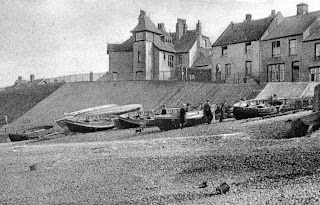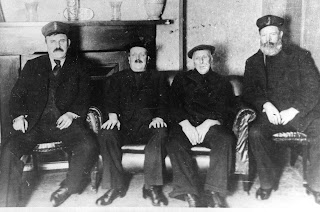I was brought up amongst the Sheringham fishing industry in the 1920’s and 30’s where there was a true community spirit.
Boat builders such as Emery and Johnson, rope spinners, North Norfolk’s sole chandlery and even the local gas works supplying tar, all played their part. Of course it was the fishermen that were at its heart but they relied on many others, especially their wives and families, so that they could do their work.
There was always a danger associated with fishing however careful a fisherman worked. Wives and other close relatives were fully aware of the risks.

 |
| Fishing Activities on Sheringham East Beach in the 1920’s |
One tragedy was recalled throughout my childhood and was linked to how we Shannocks got on with our neighbours at Cromer. Before this there were some pretty bad feeling between the two communities.
Sheringham was a larger fishing community than Cromer at the end of the 19th century and, no doubt, there was over-fishing of the crabs off the coast at that time.
 |
| Sheringham Fishermen 1930's |
Cromer fishermen accused Shannocks of using under-sized crabs as bait and invited a self-proclaimed expert to write a report. It was no surprise that his report found in favour of Cromer fishermen’s case and the resentment simmered for decades. An event in 1931 changed that.
Lifeboat Journal, June 1931
Sheringham whelk boats had gone out on 17th February 1931 in fine weather but heavy seas got up before they could return to shore. The 'Henry Ramey Upcher' lifeboat was launched and rescued two from 'White Heather II' but the conditions were such that Cromer’s motor lifeboat 'H.F. Bailey' was called to assist. Whelk boat 'Welcome Home', with a crew of three, capsized and sank 200 yards out. One fisherman was saved by the 'Henry Ramey Upcher' and a second by the 'H.F. Bailey'. The third fisherman, Jack Craske was hanging on to a spar but was unresponsive. At this point Jack J. Davies Snr, bowman of the Cromer lifeboat, jumped overboard to help Jack Craske and support him until he could be hauled aboard the lifeboat.
 |
| Jack Davies (L) Henry Blogg (R) |
It was very rare for lifeboatmen to jump overboard in the way that Jack Davies did. Sadly Jack Craske did not recover, but it was not for the want of Jack Davies’s actions. I was told as youngster that it was this single act, witnessed by the Sheringham fishermen on the beach, that wiped away those bad feelings.
Jack Craske Snr. was interviewed in a 1960's TV documentary about the life of Henry Blogg which can be seen at the East Anglian Film Archive.
That’s not to say that there weren’t some ‘ups and downs’ between us and them in later years.
When I was a youngster Sheringham fishermen crewed the pulling and sailing lifeboats 'J.C. Madge' housed at Old Hythe and the fisherman’s lifeboat 'Henry Ramey Upcher' at the west end gangway.
 |
| 'J.C.Madge' at the Old Hythe |
 |
| 'Henry Ramey Upcher' |
 |
| 'J.C.Madge' and 'Henry Ramey Upcher' under Sail |
Motor lifeboats were developing rapidly in the 1920’s and 30’s and soon proved superior to their predecessors. Everyone on the coast knew that while some of the existing pulling and sailing lifeboats would be replaced with motor lifeboats, many others would be withdrawn and their stations closed.
There was a rumour that Sheringham, as well as Blakeney, was one that was on the list of Institution stations to be closed, especially after Cromer received a motor lifeboat 'Harriot Dixon' for its No.2 station in 1934.
Several factors may have resulted in the Institution having second thoughts. There were difficulties in re-housing Cromer’s No.1 boat in bad weather and problems in launching the No. 2 boat but I think that the main reason was that Mr. Upcher, the local squire and President of the Sheringham Branch persuaded the Ancient Order of Foresters, a Friendly Society, to fund a new lifeboat 'Foresters Centenary', for Sheringham.
The closure of Blakeney lifeboat station came in 1935 and was marked by a dinner attended by local coxswains.
L-R: Charlie Long (Blakeney), James Dumble (Sheringham),
Henry Blogg (Cromer), W. Grimes (Rtd.) (Wells).
The Institution built a new boathouse, turntable and slipway at the end of the prom, that is still in use today.
 |
| The New Lifeboat House |
'Foresters Centenary', like all Liverpool class lifeboats looked fine under sail but there was not enough canvas to get more than a few knots without the engine working.

As a result, the sails were not used very often on her and most of the time she sailed with the mast and sails stowed away.
Father applied for the new post of lifeboat mechanic as he had worked with marine engines in the Navy during World War I, but Kitchener Pegg was the successful applicant.
 |
| Kitchener Pegg (L) and H. R. Johnson on Foresters' Centenary |
Lifeboats no longer needed crews of 19 or more and at first it was difficult to keep the numbers down to the authorised seven. On her first service call in 1936, to escort crab boats, there looked like upwards of ten in the crew.
 |
| Service to Crab Boats 7th August 1936 |
I remember a lot of comments from older fishermen about this new type of lifeboat work "standing and looking" compared to their efforts of pulling an oar. No question though about the courage still required.


